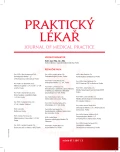The selected indicators of health status of the Czech population – results of EHES study 2014
Authors:
K. Žejglicová; J. Kratěnová; M. Lustigová; N. Čapková; R. Kubínová
Authors‘ workplace:
Ústředí monitorování zdravotního stavu obyvatelstva ve vztahu k životnímu prostředí, Ředitelka: MUDr. Růžena Kubínová
; Státní zdravotní ústav v Praze
Published in:
Prakt. Lék. 2017; 97(3): 123-130
Category:
Of different specialties
Overview
Objective:
Main goal of the European Health Examination Survey (EHES) was to obtain actual and relevant information about the non-communicable diseases risk factors among the Czech middle-aged population.
Methods:
Respondents of the European Health Interview Survey (EHIS), which was realised in 2014 on the representative sample, were asked to participate in EHES survey. The health examination involved repeated measure of blood pressure, anthropometric measures and blood sample analysis including total cholesterol blood level, HDL-cholesterol blood level and glycated haemoglobin.
Results:
There were 1220 participants aged 25–64 years of EHES survey examined; the respondence rate was 32%. The dataset was divided into two age group categories; the younger ones aged 25–44 years (n = 537, 44%) and the older ones aged 45–64 years (n = 683, 56%). The prevalence of hypertension was found in 19% of younger age group (14% females and 26% males; p < 0.001) and in 54% of older age group (44% females and 69% males; p < 0.001). Anti-hypertensive drug treatment was used by 82% of younger ones and 96% of older ones, who had the hypertension anamneses. Prevalence of prehypertension was detected in 11% of younger and 23% of older age group, who reported in questionnaire normal blood pressure. The population mean of total blood cholesterol level was 5.1 mmol/l among young and 5.5 mmol/l among old. Normal total blood cholesterol level (below 5 mmol/l) was found in 1 out of 2 young adults and only in 1 out of 3 older adults. Prevalence of diabetes was found among 2.5% of young and 12% of old (16% males a 10% females; p = 0.032) and prediabetes among 15% of young and 40% of old. The fatal cardiovascular risk in the next ten years was defined in 45% of respondents aged 45–64 year (65% males and 32% females; p < 0.001).
Conclusions:
The results show the high prevalence of NCD risk factors among the Czech population. As these factors are largely modifiable, not only the health promotion is important, but also the detection and identification of existing but not diagnosed diseases, where the main role play GPs
Keywords:
health status – cardiovascular risk, Czech population, EHES 2014
Sources
1. Catapano AL, Graham I, De Backer G, et al. 2016 ESC/EAS Guidelines for the Management of Dyslipidaemias. Eur Heart J 2016; 37(39): 2999–3058.
2. Amor A J, Masana L, Soriguer F, et al. Estimating cardiovascular risk in Spain by the European guidelines on cardiovascular disease prevention in clinical practice. Rev Esp Cardiol 2015; 68(5): 417–425.
3. Bruthans J, Cífková R, Lánská V, et al. Explaining the decline in coronary heart disease mortality in the Czech Republic between 1985 and 2007. Eur J Prev Cardiol 2014; 21(7): 829–839.
4. Cífková R, Bruthans J, Adámková V, a kol. Prevalence základních kardiovaskulárních rizikových faktorů v české populaci v letech 2006–2009, Studie Czech post-MONICA. Cor Vasa 2011; 53(4–5): 220–229.
5. Eriksen L, Grønbæk M, Helge JW, et al. The Danish Health Examination Survey 2007-2008 (DANHES 2007-2008). Scand J Public Health 2011; 39(2): 203–211.
6. International Diabetes Federation. The International Diabetes Federation Atlas, 7th ed., 2015. Brussels, Belgium: International Diabetes Federation, 2015 [online]. Dostupné z: http://www. diabetesatlas.org [cit. 13-3-2017].
7. Lewington S, Clarke R, Qizilbash N, et al. Age-specific relevance of usual blood pressure to vascular mortality: a meta-analysis of individual data for one million adults in 61 prospective studies. Lancet 2002; 360(9349): 1903–1913.
8. Mack S, Jacobi F, Gerschler A, et al. Self-reported utilization of mental health services in the adult German population – evidence for unmet needs? Results of the DEGS1-Mental Health Module (DEGS1-MH). Int J Methods Psychiatr 2014; 23(3): 289–303.
9. Piepoli MF, Hoes AW, Agewall S, et al. 2016 European guidelines on cardiovascular disease prevention in clinical practice. Eur J Prev Cardiol 2016; 23(11): 1–96.
10. Perk J, De Backer G, Gohlke H, et al. European guidelines on cardiovascular disease prevention in clinical practice (version 2012). Eur Heart J 2012; 33(13): 1635–1701.
11. Rosella L, Lebenbaum M, Fitzpatrick T, et al. Prevalence of prediabetes and undiagnosed diabetes in Canada (2007-2011) according to fasting plasma glucose and HBA1c screening criteria. Diabetes Care 2015; 38: 1299–1305.
12. Tolonen H, Koponen P, Mindell J, et al. European Health Examination Survey-towards a sustainable monitoring system. Eur J Public Health 2014; 24(2): 338–344.
13. Ústav zdravotnických informací a statistiky ČR. Zdravotnictví ČR: Stručný přehled činnosti oboru diabetologie a endokrinologie za období 2007-2015 [online]. Dostupné z: http://www.uzis.cz/publikace/zdravotnictvi-cr-strucny-prehled-cinnosti-oboru-diabetologie-endokrinologie-za-obdobi-2007-2015 [cit. 13-3-2017].
14. World Health Organization. Global atlas on cardiovascular disease prevention and control. WHO: 2011 [online]. Dostupné z: http://www.world-heart-federation.org/fileadmin/user_upload/images/CVD_Health/Global_CVD_Atlas.pdf [cit. 13-3-2017].
15. World Health Organization. Global status report on noncommunicable diseases 2014 [online]. Dostupné z: http://apps.who.int/iris/bitstream/10665/148114/1/9789241564854_eng.pdf?ua=1 [cit. 13-3-2017].
16. World Health Organization. Global Health Observatory Data Repository [online]. Dostupné z: http://apps.who.int/gho/data/?theme=main [cit. 13-3-2017].
17. Lai YJ, Lee ST, Kuo SC, Chou P. Comparison of fasting plasma glucose and glycated hemoglobin for diagnosing diabetes in a Taiwanese population. Metab Syndr Relat Disord 2015; 13(5): 203–207.
Labels
General practitioner for children and adolescents General practitioner for adultsArticle was published in
General Practitioner

2017 Issue 3
- Memantine in Dementia Therapy – Current Findings and Possible Future Applications
- What Effect Can Be Expected from Limosilactobacillus reuteri in Mucositis and Peri-Implantitis?
- Memantine Eases Daily Life for Patients and Caregivers
- Metamizole vs. Tramadol in Postoperative Analgesia
Most read in this issue
- Preeclampsia is not just a complication of pregnancy
- Drug combinations in the treatment of obesity: the past and present
- Patient-centered care: general aspects and terminology challenges
- The selected indicators of health status of the Czech population – results of EHES study 2014
